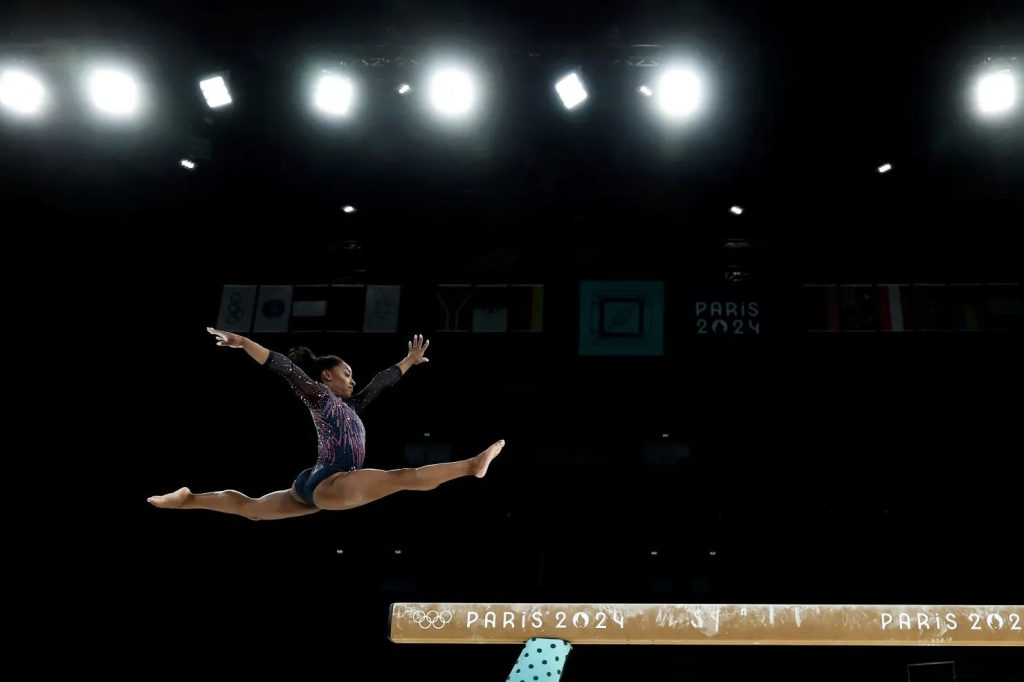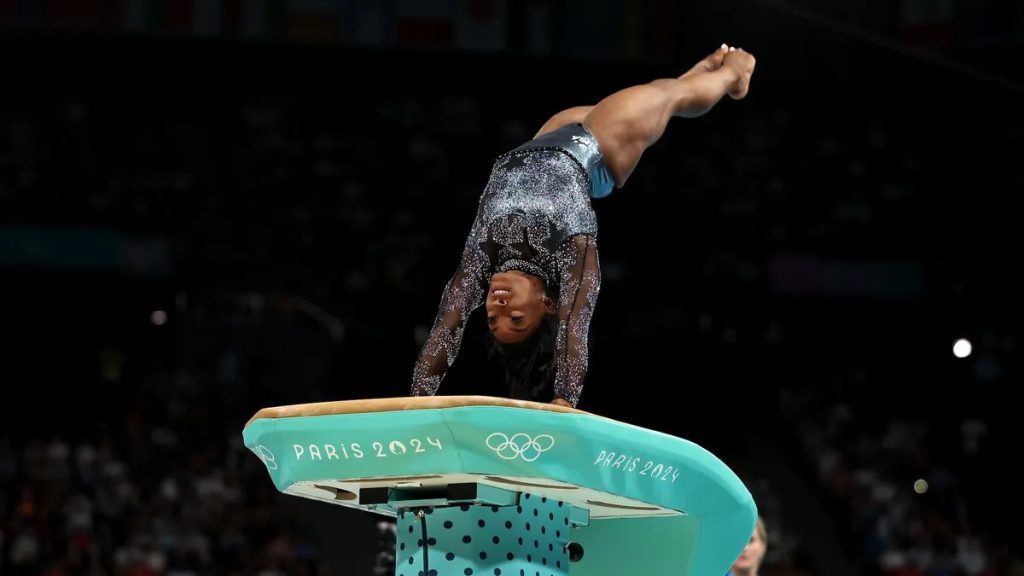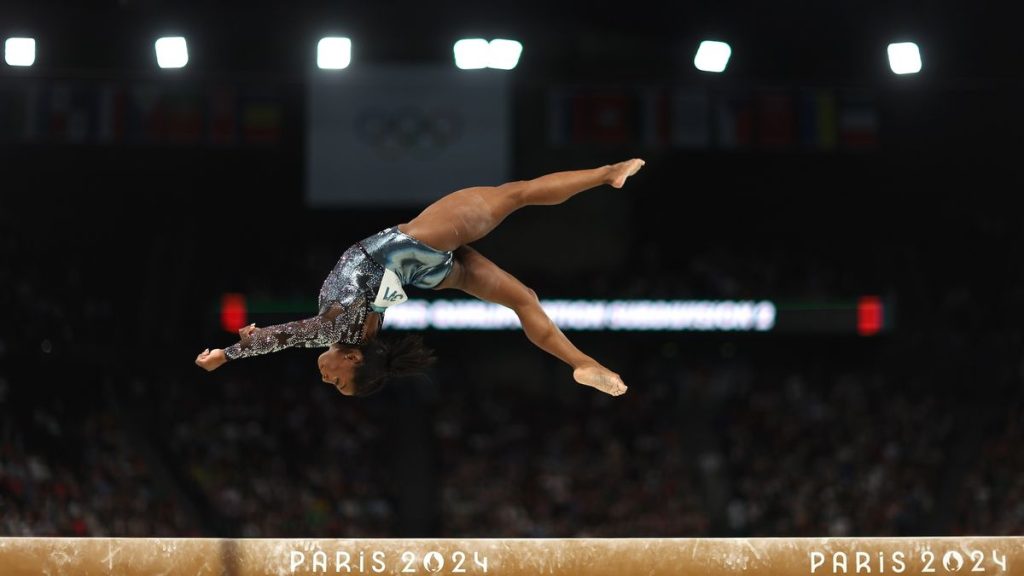Another Olympics, another set of stellar performances by the U.S. women’s artistic gymnastics team. A stream of individual and team gold medals. But for Simone Biles … a real 5 ⭐️ performance.
It feels like each day gymnasts compete, we are left to pick our jaws off the floor and wonder: just how in hell do they do that?!!



4 August 2024 (Washington, DC) — When I was at university, I earned a physics degree. It was a “minor degree” which meant I had a reduced course load from my “major degree” (which was economics).
And – irony of ironies – it was that physics degree that got me my first job, on Wall Street. Before law school, I spent 3-1/2 years on The Street learning about *real* life in the commercial and legal world, first as a currency trader, hired for that minor degree, funnily enough. The physics behind trading and technical analysis is an interesting story but it needs a separate post.
I then stumbled into a position as a software analyst because the proprietary trading software we were using at my firm was going to be licensed and my trading firm set up a special unit to handle that licensing.
Long story short: waaaaaaay back in 2010 I met Nick Patience (one of the founders of 451 Research, a person and company many of my readers know well). Nick invited me to attend the annual 451 Hosting & Cloud Transformation Summit in London. I had known Nick for a number of years and he had invited me to several 451 events where the knowledge I gained informed my eDiscovery/information management blog posts.
But the Cloud Summit was different. Nick introduced me to Brian Cox, who was the keynote speaker. Brian, as most of you know, is Professor of Particle Physics and one of the leaders on the ATLAS experiment at the Large Hadron Collider (LHC) at CERN in Geneva. He is a physics star turned pin-up professor whose several series on the solar system and science have sent his career into orbit. Universities who have seen a surge in applications for physics programs call it the “‘Brian Cox effect”.
Brian dazzled the crowd with real data loads. Like the 40 terabytes the LHC was creating – per second.
That introduction led to an email exchange, and an invitation to CERN to see the LHC, which is located near Geneva, Switzerland. It rekindled my interest in physics and it led to a whole string of further introductions at the Swiss Federal Institute of Technology (ETH), the Swiss AI Lab, the Delft University of Technology, the Grenoble Institute of Technology, etc., etc. And it also led to my AI/informatics program, and has generated umpteen astronomy and space exploration posts.
But that physics background does nothing to help me understand how Simone Biles seems to defy physics. So I have turned to others.
At 4′ 8″, Simone is a very, very rare bird. She is considered one of the greatest gymnasts of all time. So what’s the science behind her success?
According to Gina Pongetti, a former gymnast and physical therapist who is treating athletes at the 2024 Paris Olympics and who has interviewed on one of the French sports channels, “Simone is being Simone”. Beyond that, the answer lies in Biles’ dedicated training of her neuromuscular system — everything from the ribbon of tissue that traverses the frontal lobe in the brain and controls movement to the sensory receptors that provide feedback to the muscles themselves:
“To be an elite athlete is one level. To step up to Simone’s level involves an absolute keen understanding of her body and the input signals that come to it. Biles stands out from other gymnasts both in terms of how she senses her body in space and how she hones her muscle memory, as well as her having one of the most phenomenal bases of strength and conditioning that I’ve ever seen in an athlete”.
Pongetti added:
“Biles started gymnastics at 6 years old. A youthful start is common among elite gymnasts; growing brains are adept at taking in information. And that early practice often provides a basis for later adeptness. Particularly important to gymnasts is proprioception, the sense of where one’s body is in space. The sense depends on signals from specialized cells within muscles, tendons and joints. In muscles, for example, bundles of nerves called muscle spindles tell the brain how stretched or contracted a muscle is. In the skin and joints, receptors known as Pacinian corpuscles react rapidly to sensations of pressure.
So when Biles competes on the vault, these corpuscles are one of her key informants as to how squarely her palms hit the apparatus and if she’s effectively transferred the force she needs to launch into and twist through the air. None of those decisions are conscious. The movements happen so quickly that the motor planning has to be preordered in advance”.
She compared it to a fireworks show, in which fuses of different lengths are lit at the same time. The programmed sequence is triggered when the gymnast takes their first step.
In motor learning, linking together movements in this way is called “chunking,” said Gregory Youdan, an independent movement scientist and dancer in New York City. “Because it’s chunked, it frees up a little bit more cognitive load for other things and allows for that automaticity”.
So throughout the sequence, the proprioception system tells the athlete if all is going well. The muscles and fascia – the nerve-rich casing that covers the muscles and organs – respond accordingly with the required movements to make tiny corrections.
And that’s where Biles’ famous work ethic comes in. To reach that level of automaticity, gymnasts have to practice perfectly, Pongetti said. It’s a step-wise process that begins in a gym’s loose-foam pit, a swimming-pool-like structure filled with foam cubes where gymnasts can fall without hurting themselves.
From there, the athletes slowly build up to doing the routine on the gymnastics floor, without padding:
“As each step progresses, your level of confidence should increase, thereby allowing you to take more risks of a less-forgiving landing”.
Dr. David Neuman, a fellow of the American Academy of Orthopedic Surgery and clinical director NY Sportscare in Manhattan, referred me to a 2004 study. In that study, scientists used a sequence of finger movements – rather than gymnastic routines – to investigate how this type of memorized motor learning becomes automatic. The same brain areas lit up when people were first learning the finger movements and after they learned to do them automatically.
However, brain activity declined slightly in many regions once the movement became automatic, suggesting that automaticity stems from an increase in singaling efficiency.
In 2016, researchers proposed a new theory dubbed the Optimizing Performance Through Intrinsic Motivation and Attention for Learning (OPTIMAL) theory of motor control. This suggests that honing an external focus of attention — on the outcome of the movement, rather than the precise focus on a single body part — helps to smooth this learning process. Said Dr. Neuman:
“Athletes focus relentlessly on process and technique. Practice doesn’t only make perfect; it also makes poise: by drilling skills over and over, elite athletes can stay cool and focused in stressful competitions”.
He said Biles carries serious muscle on her 4-foot, 8-inch (1.4 meter) frame, a body type that gives her a lot of efficiency in her movements. Her quickness, bestowed by fast-twitch muscle fibers that contract quickly with a burst of force, is just as important as her power. Gymnasts also need isometric strength, which is the ability to produce force with muscle without shortening its length. This involves stiffening a muscle without moving its associated joint. That stiffness enables gymnasts to rebound off the floor or vault table, getting the air they need to execute a twist or flip.
And finally, there’s the landing. At that critical moment, Pongetti (the former gymnast/physical therapist treating athletes at the 2024 Paris Olympics who I introduced above) said the muscles need to absorb the force generated by all those spins and flips with an eccentric contraction, which is when the muscle contracts while lengthening. Think of slowly lowering a dumbbell in a bicep curl, during which the bicep muscle is working hard as it’s extending. She said:
“Biles is excellent at absorbing those forces without wobbling or hopping, which enables her to stick her landings neatly. Beyond practicing the skills themselves and doing the strength and conditioning needed to execute them, elite gymnasts have to focus on flexibility, nutrition, recovery time, mental wellness, rehab for injuries, and scheduling events and competitions so as not to overtax themselves. A lower-level gymnast may spend only 10% of their time thinking about those non-skills factors, she estimated, while someone like Biles might devote at least a third of their time to them”.
This focus on the foundations of performance becomes increasingly important in a long career like Biles has, now competing at age 27.
Another key to high performance is knowing when to step back. Biles famously withdrew from most events in the Tokyo Olympics in 2021 after developing the “twisties,” a psychological phenomenon in which gymnasts lose their sense of where they are during flips and spins. The twisties are not only disorienting — they’re dangerous, especially for gymnasts attempting particularly daring skills. Said Pongetti:
“Look at the strength it took her to step away when she knew that she needed to for her own self, and look at the strength that it took to come back again. That inner strength is tough to quantify and even tougher to replicate.
Simone is a very, very rare bird. For her from such a young age to be so awesome and so elite and then go through her mental health struggles and then to come back and be one of the oldest people on the team – that’s endurance and resilience right there, for her to be able to do that. That’s why people love watching her”.
Jack Mifsud, a long-time friend who studies physics in sports, says Biles secret also lies in an extraordinary mastery of the physics behind every bounce. While the sprung floors and vaults of gymnastics events provide a bouncy, propulsive surface, making full use of that rebound requires incredible neuromuscular control and precise timing from the athletes:
“It’s not just about muscular strength which your sports doctors have explained very, very well. Gymnasts have to perfectly tune the stiffness of their spring-like legs on landing. To do this, they activate their muscles in very specific patterns to essentially turn their legs into optimised “springs” for whichever apparatus they’re working on – it will differ from floor to beam, to vault”.
But that’s only half the battle:
“The gymnasts must also harness that loaded muscular tension and release it at the precise millisecond to generate maximum push-off force from the floor, vault or beam. It’s like knowing exactly when to push on a swing to send it soaring highest.
Switching on those explosive jumping muscles even a fraction early, or late, can mean the difference between a sky-high tumbling pass or crashing back down to earth”.
Biles, who has rewritten the record books and is the undoubted greatest of modern gymnastics (arguably among women and men), is renowned for her mixture of power, body control, and impeccable timing of these mechanics. As Jack explained, her ability to both stiffen her legs like tightly coiled springs and unleash that energy at the perfect instant allows her to soar and spin in a manner once thought impossible:
“She has the complete trifecta – outstanding muscle strength, precision ‘tuning’ of her leg stiffness, and timing so exact it defies belief. Replicating that combination may be one of the greatest challenges facing the next generation of gymnasts, and those who tried to beat her in the Bercy Arena in Paris”.
As Biles has etched her name atop the all-time Olympic greats in Paris, the world has once again been in awe of her physics-defying aerial feats. An appreciation of the scientific mastery behind those soaring routines only adds to the amazement.